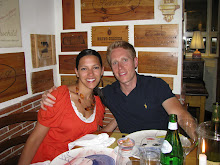
When I started this blog I thought maybe I should write an ode to the chickpea. I mean I eat them almost every day; by the handful, in salad, roasted in the oven until crunchy. Cheap, providing protein and complex carbs (fiber too), vits and mins, they are almost a perfect food to me. They make me wonder why they say it's so difficult to eat healthy when you have a low income. Beanth! So this recipe is the first foray into one of my dietary staples.
Here I utilize chickpea flour rather than chickpeas in whole form. It is available at Whole Foods or online in bulk. You can do a lot with it; mix into breads, or use it to coat things like shrimp and calamari before frying for a subtle nutty flavor you don't get from white wheat flour. It's also gluten free for an added bonus.
When I was in Italy I took a trip to the Ligurian coast where, propped against steep cliffs and little inlets are the Cinque Terre, or five villages. Picturesque little towns comprised of craggy outcroppings on which pastel colored buildings seem precariously embedded in the earth. There's very little road access so the most common ways of going between villages are the trains which cut in and out of the ocean cliffs, or on foot. There are trails that snake around the sea, abutting terraced olive groves and vineyards, rising and falling hundreds of feet from one town to the next. A unique place for hiking in Italy, and when hunger ensues there's a near perfect snack to fuel the trek to the next village.
During my short stay in Cinque Terre I woke up the first morning and smelled the aroma of olive oil heating up nearby. Upon further investigation I came across a little paneficio, or bread shop. I needed something for breakfast, and I knew it wasn't going to be eggs or cereal, more likely some kind of light sugary pastry, good enough for about forty five minutes of satiation. But the aroma which brought me to this place was coming from a large rectangular pan just out of the oven, something golden and glistening from an abundance of oil.
I ordered a piece of it by about yea big and got it served up on some parchment. Oily it certainly was, hot and slightly crunchy at first. I initially thought it might be some kind of crepe or something made with egg, but then I discerned a certain nuttiness and earthiness, the egg fading away to nothing. I ordered some more and when I found out what it was figured my ulterior motive for hiking all day would be to try the farinata in each village I could hit by sundown.
The thing I love about farinata is how simple it is; chickpea flour, made into a batter with water, a very liberal dose of good olive oil and some salt. Satisfying, cheap, eaten on the move, and something that shouldn't have any allure to people like us who have more food options in a given day than we know what to do with. But what was bare subsistence or someone else's trash is now intriguing and sought after by hobby eaters.
Makes 2 farinate in a 10" skillet
Ingredients:
2 cups of chickpea flour
2 2/3 cups water
1/3 cup extra virgin olive oil
1 sprig fresh rosemary, needles finely diced
1/2 tablespoon sea salt
Black pepper to taste
Equipment:
Flour sifter (optional but suggested)
Cast iron skillet. If you don't have one use a sheet pan instead

Pour the water into a mixing bowl and begin sifting the flour in while whisking until all the flour is incorporated and you have a non-lumpy batter. It should be thinner than pancake batter, like heavy cream. Let this rest at least an hour, as long as overnight--the longer the better up to that point.
Preheat the oven to 500. Put the cast iron skillet in the oven for 10 minutes, or a sheet pan in for 5. In the meantime, stir in the olive oil, salt, and rosemary to the batter.

Take out the skillet or pan from the oven and drizzle in a teaspoon of olive oil and roll it around to coat quickly, then add half the batter, which will sizzle and begin to set immediately, to a depth of no more than half an inch, preferably a little less.













